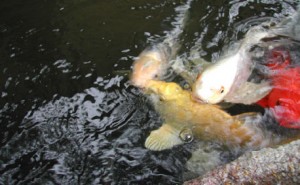Koi & Japanese Ponds
 March 2, 2012
March 2, 2012
Koi can be a wonderful addition to your Japanese garden pond, or koi pond. Some Japanese gardeners believe that koi do not belong in a truly authentic Japanese garden even though they do not deny their beauty. This opinion also seems to be more of a minority than the majority. It seems that more often than not where you find a Japanese garden with a pond, you find koi.
Koi add an important element in the ecosystem of a Japanese garden koi pond. We have used koi in ponds and sometimes water features too. They help by reducing the need for chemicals and improve water quality throughout the summer. They also help control algae and eat mosquito larva and several other aquatic creatures that are found in backyard water features.
Water gardening is a truly enjoyable and growing hobby that is only made better with koi. Although there is no limit to the minimum number of koi you can have in your pond there is a limit to how many you can have. A good rule of thumb is measure the surface area of your pond and not add any more than 2†of fish (in length) per square foot of surface area. Even though this ratio allows for the growth of your koi, always error on the side of having fewer fish than the maximum allowed.
Many pond owners will mix in a few gold fish along with their koi. These two fish are the primary choices for outdoor ponds and are both members of the carp family. Koi have been bred from the common carp and the art of raising them has been handed down from generation to generation in Japan.
Your pond should be cleaned and running in the spring before fish are added. You should allow 48 hours or more after filling your pond before adding any fish. It is best to test the water with gold fish before adding your prized koi. Koi, like aquarium fish are usually brought home in a plastic bag. Place the bag in the pond and let it float on the surface out of any direct sun light. This is known as “floating the bagsâ€. It usually takes between 30-40 minutes before the temperature of the bag to adjust to that of your pond. When you release the koi you should allow them to swim slowly from the bag into their new environment, never dump a bag with koi, into a pond.
It is not necessary to feed for you koi for a few days, as they typically eat very little when first moving into a new home. Like most pets it is helpful to develop a consistent feeding pattern, so feed them from the same spot at the same time each day. It doesn’t matter whether you choose a morning or afternoon feeding time. It is better to not over feed your fish, however if they eat the food very quickly you can give them a little more. All of the food fed to your fish should be eaten within about five minutes. Remember that you want them to help eat mosquito larvae. Koi and gold fish often require little maintenance.
The biggest challenge with koi is predators, such as: cats, raccoon, mink and birds. If you run into these problems you can try a black plastic netting to cover your pond for a few weeks. If the problem persists to the point where you always need a protective covering, I would recommend bringing your koi to another holding location for awhile giving the predators time to find a new feeding area, or source of food. If this still does not work it is probably better to enjoy your Japanese garden pond without the netting.
If you are interested in our help with a Japanese koi pond please contact us, Niwa Design Studio, at 952-470-1882.

 Posted in
Posted in  content rss
content rss